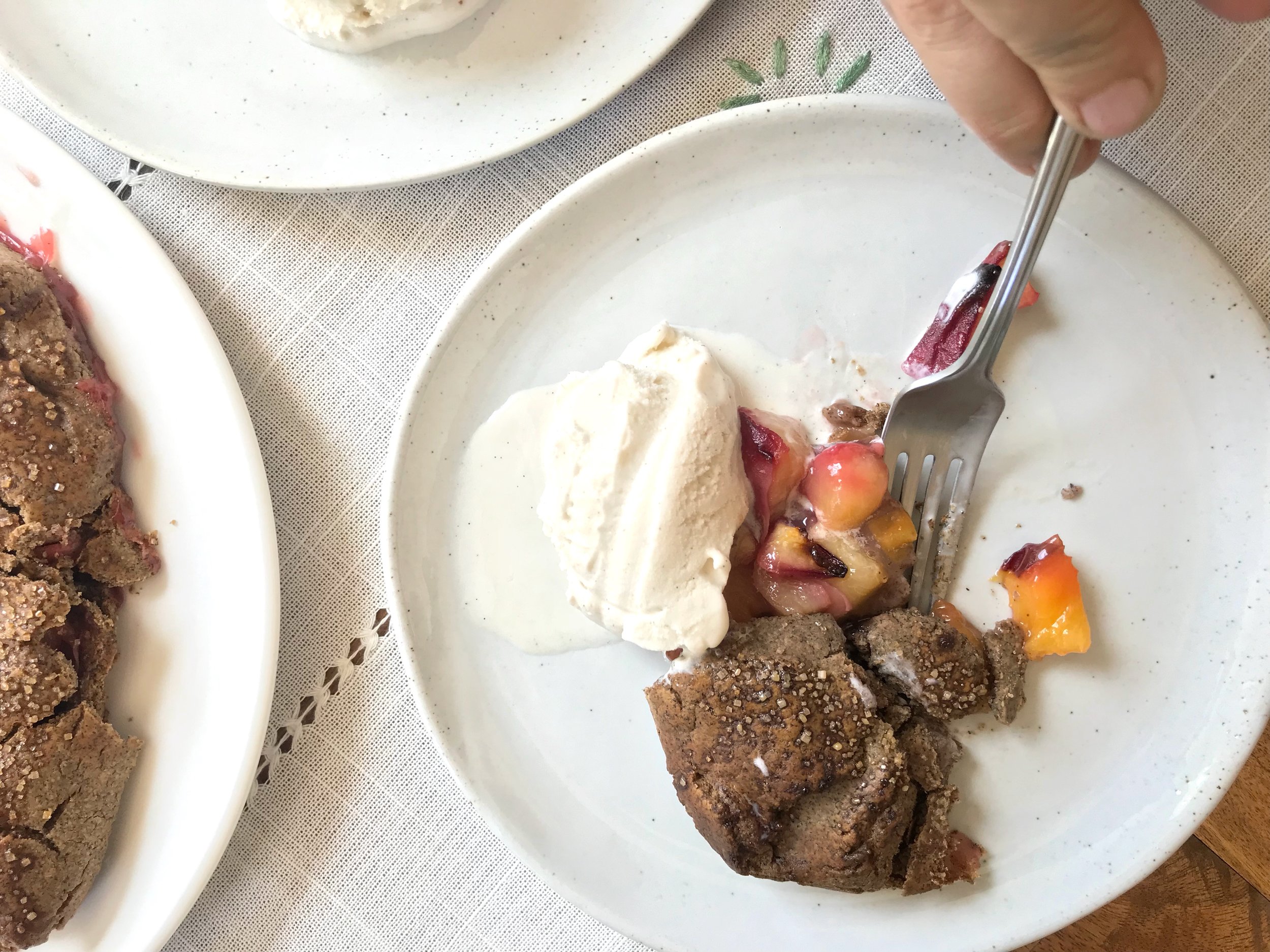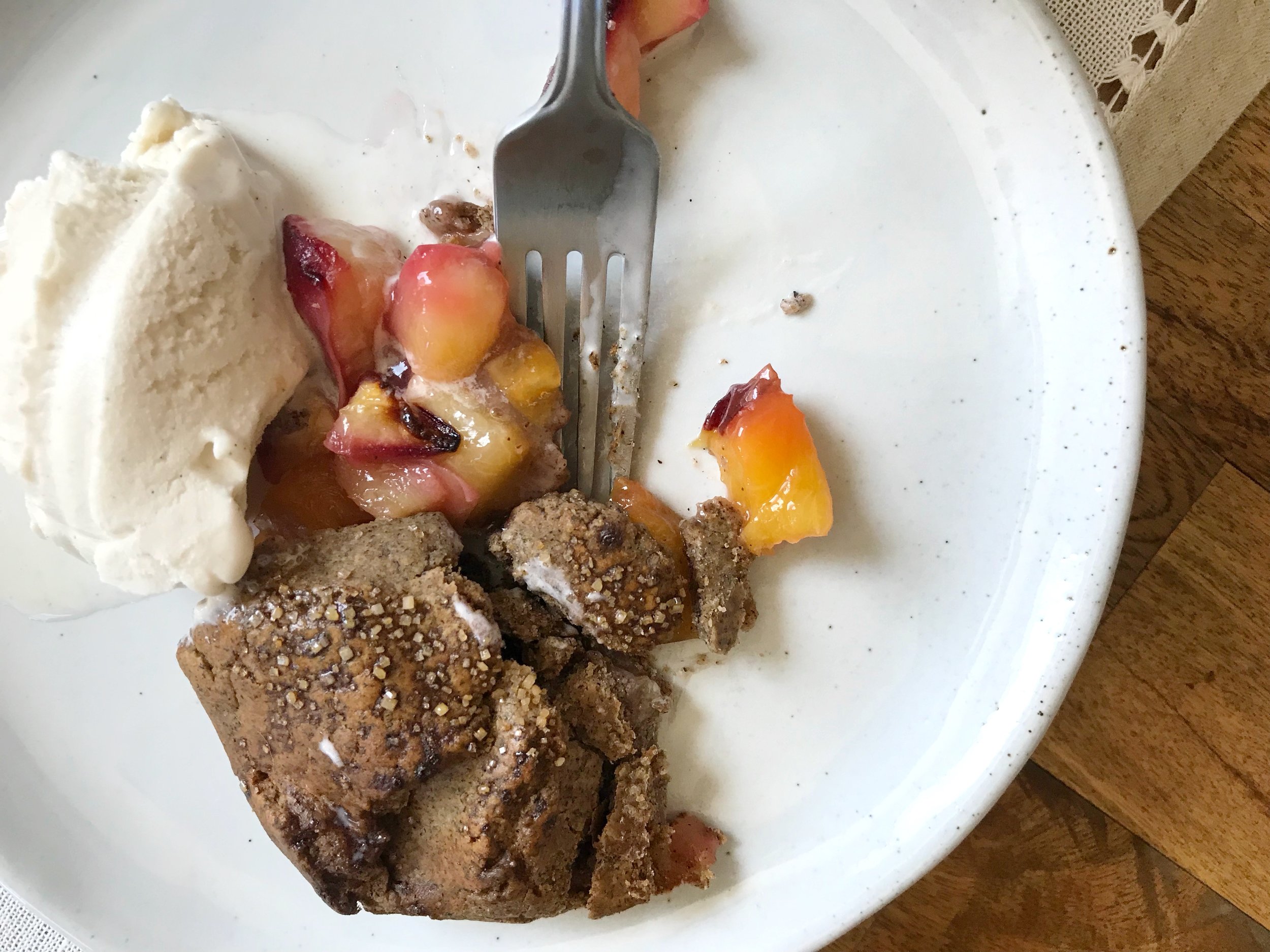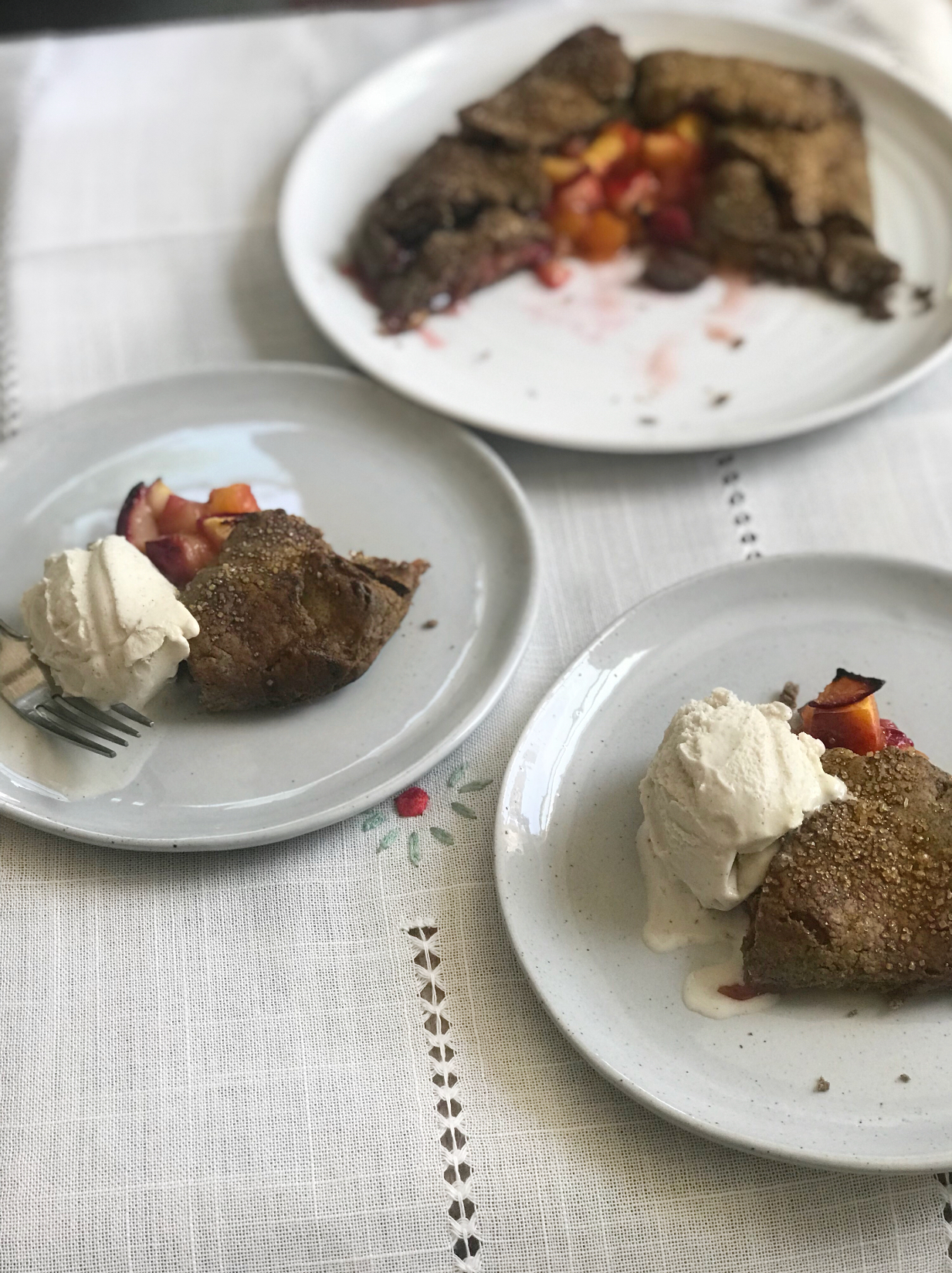Sweet or Savory Buckwheat Galette
One great way to feel like you’re eating something healthy and “organic” is to add buckwheat. I get it from the natural-food co-op a few blocks from my apartment, where it’s stocked in bulk bins, right next to the carob chips and the hemp seeds—the same store I went to one summer evening, on a mission to make a caprese salad for one, and walked out having spent no less than $75 on the three main ingredients. (But ooooh, boy. Those tomatoes.) Buckwheat fits right in at the natural-foods co-op not just because it’s gluten-free, but because it has a hearty, rustic flavor, and a warm, earthy color, flecked with dark husks that make it feel just like the nutritious whole food it is.
The galette, then, is the perfect vehicle for buckwheat: Hearty and rustic in its own right, this easy-going pastry pocket gets filled with healthy fruits or vegetables (plus cheese!), baked in a 425-degree oven, and served up in all its homely glory, most often as a summer brunch or dessert (though it deserves a spot at the dinner table, too). The dough itself is easy to make and endlessly forgiving, and works with both sweet and savory fillings. You can dial up the buckwheat to your liking (I like a lot; Dylan likes less), and add a healthy dose of flaky salt or turbinado sugar (another co-op resident ingredient) to accommodate savory or sweet fillings. No matter how you choose to serve it, a warm-and-toasty buckwheat galette is one perfect, and easy, way to show off your inner organic goddess.
PSST: Love buckwheat? Try this lovely soba noodle salad!
Design-Your-Own Rustic Buckwheat Pie-Pocket
With some super-simple adjustments, you can customize this easy dough recipe to your liking. The key is this: Focus on ratios. The amount of flour in this recipe—that is, all-purpose flour plus buckwheat flour—is 180 g total, or about two cups. You can distribute the buckwheat-to-all-purpose ratio however you want, to dial the buckwheat flavor up or down. For example, you can use 50/50 buckwheat to all-purpose for a very dark, rustic galette, or you can go 20/80 buckwheat to all-purpose for just a whisper of whole-grain flavor. This recipe calls for 30/70, which we think is a nice, balanced dough.
The dough is exactly the same for sweet or savory galettes (though you can add a 1/4 cup sugar to the sweet one, if you want). The savory one gets a flaky-salt rim before baking, whereas the sweet one gets a sprinkle of turbinado sugar.
Time: 2 hrs, mostly inactive
Active Time: 15 min
Serves: 4–6
For the dough
For savory filling
For sweet filling
Do the dough
1. Combine flours, salt, and butter
Combine flours, salt, and butter in a medium bowl. Mix with your hands until you get pea-sized lumps of butter throughout.
2. Whisk ice water and egg yolk; add to flour mixture
Add the egg yolk to 5 tablespoons of ice water in a small bowl and whisk with a fork to combine. Add to the flour/butter mixture. (Whisking the water and yolk in advance helps to distribute the yolk more evenly.)
3. Knead
Mix with your hands until the dough starts to come together. Turn it out on a floured work surface and knead a few times until well-combined and smooth. If it’s dry and crumbly, add more water, one splash at a time, until it starts to come together.
4. Shape into a disk; wrap with plastic
Shape the dough into a flat disk about six inches wide. Wrap tightly with plastic wrap.
5. Chill for an hour
You’ll want it nice and cool when you add the filling. You can make the dough in advance and reserve it in the fridge for up to a week.
Savory filling
1. Preheat oven to 425 F
2. Drain squash and zucchini
Combine grated squash and zucchini in a colander. Add a healthy dose of kosher salt to remove moisture, and let sit for at least 30 minutes (or up to a couple hours) in the sink, to let the moisture drain out.
3. Transfer to a bowl; add Gruyère
Mix with your hands until well-incorporated. Add some pepper to taste.
4. Form galette
Cover a sheet pan with parchment paper.
On a floured surface, roll out your galette dough until it’s about 1/4-inch thick, and about a foot in diameter. Make sure it’s not stuck to the surface at all. If it is, peel it up, add more flour to the work surface, and roll it again. If you get any cracks, just pinch them back together with a little water.
Add the filling. Spread it out to reach an inch or two from the edge of the dough. Gently fold the sides in toward the center. Don’t worry if it breaks—you can pinch it back together, but it also doesn’t really matter if the dough has some tears.
Transfer the galette onto the parchment paper. If it sticks to your surface, use a bench scraper or a butter knife to dislodge it.
5. Brush with egg wash; sprinkle with salt
In a small bowl, whisk one whole egg and a tablespoon of cold water. Brush onto the exposed surface of the dough. Sprinkle some flaky salt all salt bae.
6. Bake 30–45 minutes
Bake that puppy til the filling and the dough are gloriously golden-brown. Start checking at 30 minutes and go until the level of brown and bubbling looks good to you.
7. Rest; serve
Let it cool for 10 or 15 minutes before serving. Slice it up and eat it with a nice bright salad.
Sweet filling!
1. Preheat oven to 425 F
2. Make fruit filling
Combine all ingredients in a medium bowl, and gently mix. Let it rest in the fridge for a few minutes, or up to an hour, to get all gooey.
3. Form galette
Cover a sheet pan with parchment paper.
On a floured surface, roll out your galette dough until it’s about 1/4-inch thick, and about a foot in diameter. Make sure it’s not stuck to the surface at all. If it is, peel it up, add more flour to the work surface, and roll it again. If you get any cracks, just pinch them back together with a little water.
Add the filling. Spread it out to reach an inch or two from the edge of the dough. Gently fold the sides in toward the center. Don’t worry if it breaks—you can pinch it back together, but it also doesn’t really matter if the dough has some tears.
Transfer the galette onto the parchment paper. If it sticks to your surface, use a bench scraper or a butter knife to dislodge it.
4. Brush with egg wash; sprinkle with salt
In a small bowl, whisk one whole egg and a tablespoon of cold water. Brush onto the exposed surface of the dough. Sprinkle some turbinado sugar for extra crunch and sweetness. (Don’t have turbinado? Granulated sugar works, too—you just won’t get those pretty grainy chunks.)
5. Bake 30–45 minutes
Bake ’er up til the crust is golden-brown, and the filling is clear and bubbly. Start checking at 30 minutes.
6. Rest; serve
Let it cool for 10 or 15 minutes to set. Serve with some vanilla bean ice cream!
Um, excuse me?
My galette leaked! Is it ruined?
No way, Jose! My galettes leak 90% of the time, and they still taste damn good.
I’m not into buckwheat. Can you give me a normal galette recipe?
Sure! Dylan has a non-buckwheat galette coming soon. If you want it ASAP, tell us in the comments!
What’s up with the grams?
I bake everything by weight. I was converted when I worked with the pros at ChefSteps for four years. It’s faster, easier, and makes way fewer dishes. I’ll write something about it soon.
Why is the cook-time window so big?
Here's the deal about ovens and galettes—every single one is different. Some ovens need more or less time. Also, some galettes need more or less time. Your dough will be good to eat after 30 minutes, and still delicious after 45 minutes, so base your cooking time on what's inside. Cheese and grated zucchini needs less time; hearty apples and brown sugar might need more.
I don’t like squash and zucchini, what else can I use?
I love a goat cheese base, with sautéed leeks, asparagus, and lemon zest. But galettes are versatile—get creative!
What about other fruits?
The fruit is easily replaceable. We used peach and nectarine, but just about any berry will work, or you could do apples and pears. Stone fruits and berries need less cook time; apples and pears need more.














